SIG Sauer SRD9
By: Sean Utley
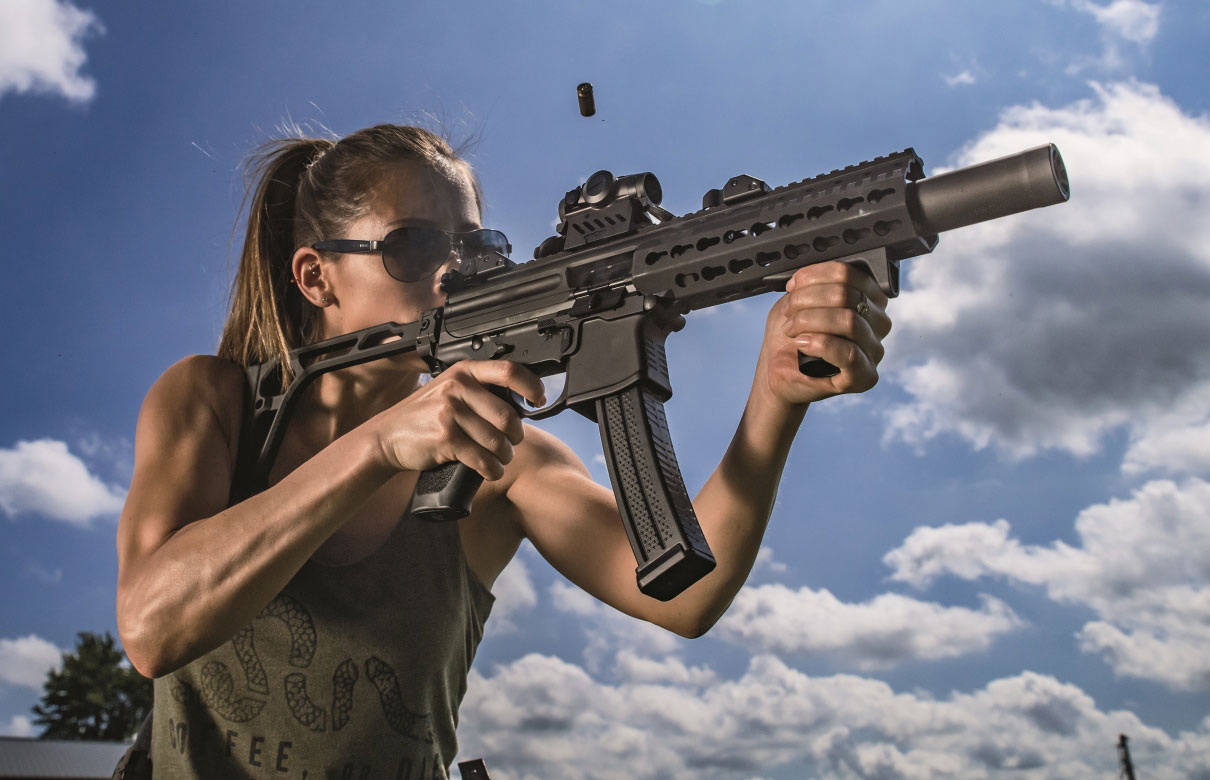 The SRD9 suppressor is tough, built to a professional-grade level of durability, yet still lightweight. (Sean Utley photo)
The SRD9 suppressor is tough, built to a professional-grade level of durability, yet still lightweight. (Sean Utley photo)
Professional-grade silence
SIG Sauer developed their silencer division about five years ago. Currently, the company seems to have their hands in every shooting facet, moving from solely producing firearms to providing firearms solutions across the globe. This applies not only to their military/law-enforcement divisions, where SIG Sauer has become the choice for many professional teams and units, but also on the commercial side. They also provide training through the SIG Academy, which is rich with a more-than-qualified training cadre. If you’ve been to the facility, you know about their incredible pro shop. If you haven’t been yet, make plans to go.
Since their silencer division’s inception, they have turned out some of the most innovative suppressors on the market. They boast excellent advances in sound attenuation by producing rifle-caliber suppressors without the traditional outer tube, leaving more volume inside to dampen sound. Their products also challenge the aesthetic norms of suppressors. Whether you love their suppressors’ looks or hate them, they are impressive, effective tools. What’s more is their products are affordable. Last year, Suppressor hailed the SRD762 as a “huge bargain.”
Pistol Suppression
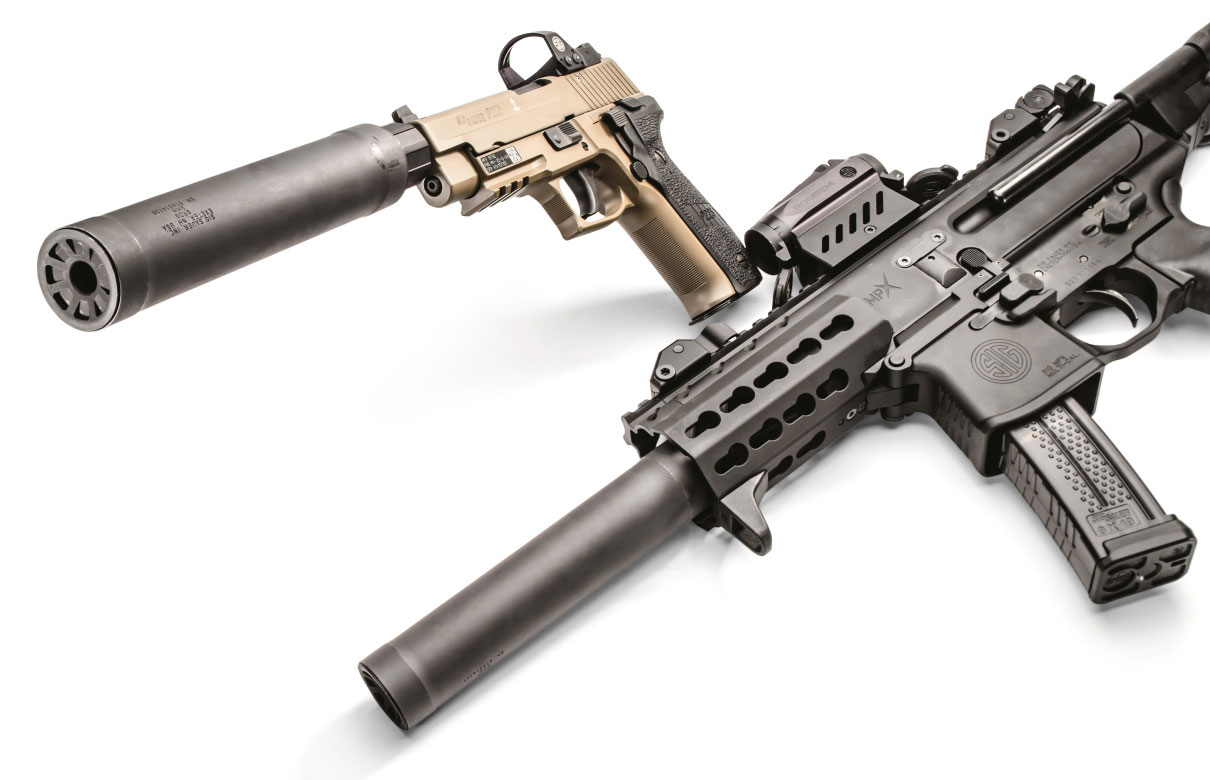
The SRD9 is designed to withstand the rigors of diverse shooting conditions worldwide, including +P and +P+ ammo. (Sean Utley photo)
With a successful rifle suppressor launch, SIG Sauer immediately turned their attention to developing pistol suppressors. The SRD45 hit the streets in 2015, and this year, the SRD9 was introduced.
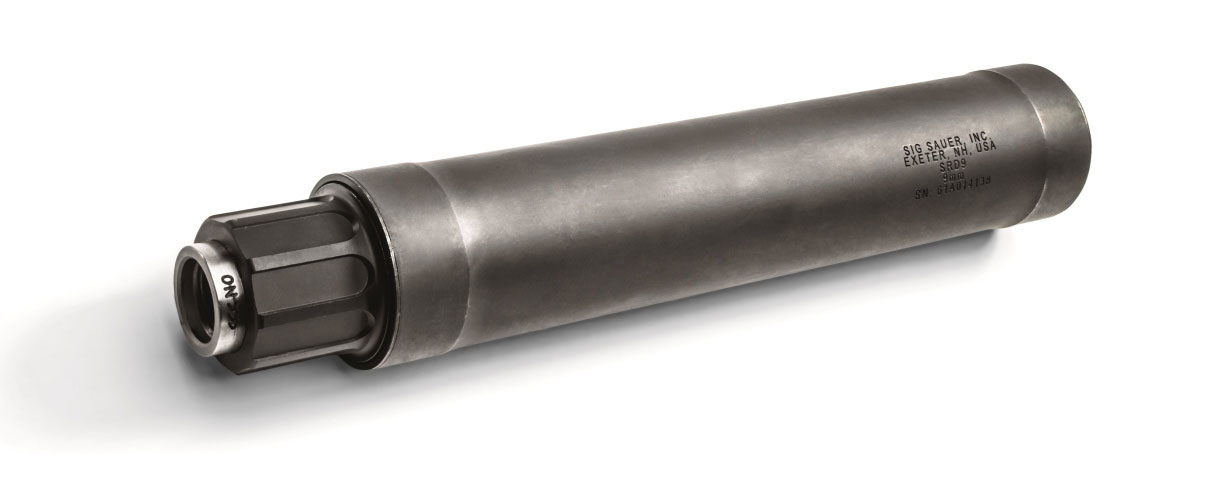
If you’d like to run the SRD9 on something other than a pistol, be sure to order a fixed-barrel spacer to avoid damaging your suppressor or firearm. (Sean Utley photo)
The SRD9 started its life as a chunk of tough 17-4 PH stainless steel that was cut into expertly designed baffles, then squeezed into a tough, Grade 9-titanium tube. The end cap is aluminum, and the combination of these materials provides the SRD9 great strength without excessive weight: The SRD9 rests at 13.5 ounces.
SRD9
Materials: Titanium, 17-4 PH stainless steel
Cartridge: 9mm
Overall Length: 7.8in.
Weight: 13.5 oz.
Diameter: 1.38 in.
Manufacturing Noise Rating: 128 dB (dry)
Attatchment Type: Direct thread
Finish: Gray PVD
MRSP: $695
Manufacturer: SIG Sauer
Durability is paramount with the SRD9, and for good reason. Because SIG Sauer caters to military and LE customers, they needed a design that could survive hard use from domestic and international customers with varying levels of ammunition resources. Many of these customers utilize whatever types of ammunition they are delegated, and often this includes +P and +P+ versions. You might automatically assume that subsonic ammo would be used for optimized noise reduction, but that isn’t the case. According to sources within SIG Sauer, many of their customers don’t have access to subsonic ammunition. Stringent universal standards force SIG Sauer, as well as many other companies, to make better products that last, and shooters reap the benefits.
Boosters
For proper operation in pistols with Browning-type actions in which the barrel tilts during cycling, SIG Sauer provides a booster to ensure proper cycling. While this is the norm for any suppressor manufacturer, SIG Sauer goes further by providing two boosters with each SRD9. As long as you don’t have nonstandard threading, you should be able to immediately attach the SRD9 to any standard- or metric-thread-equipped pistol. You won’t be stuck waiting an extra week on your booster order after already waiting who knows how long for your suppressor. If you desire to run your SRD9 on something other than a pistol – a SIG MPX, for example – you’ll want to order one of their fixed-barrel spacers to avoid damaging your suppressor or beloved firearm.
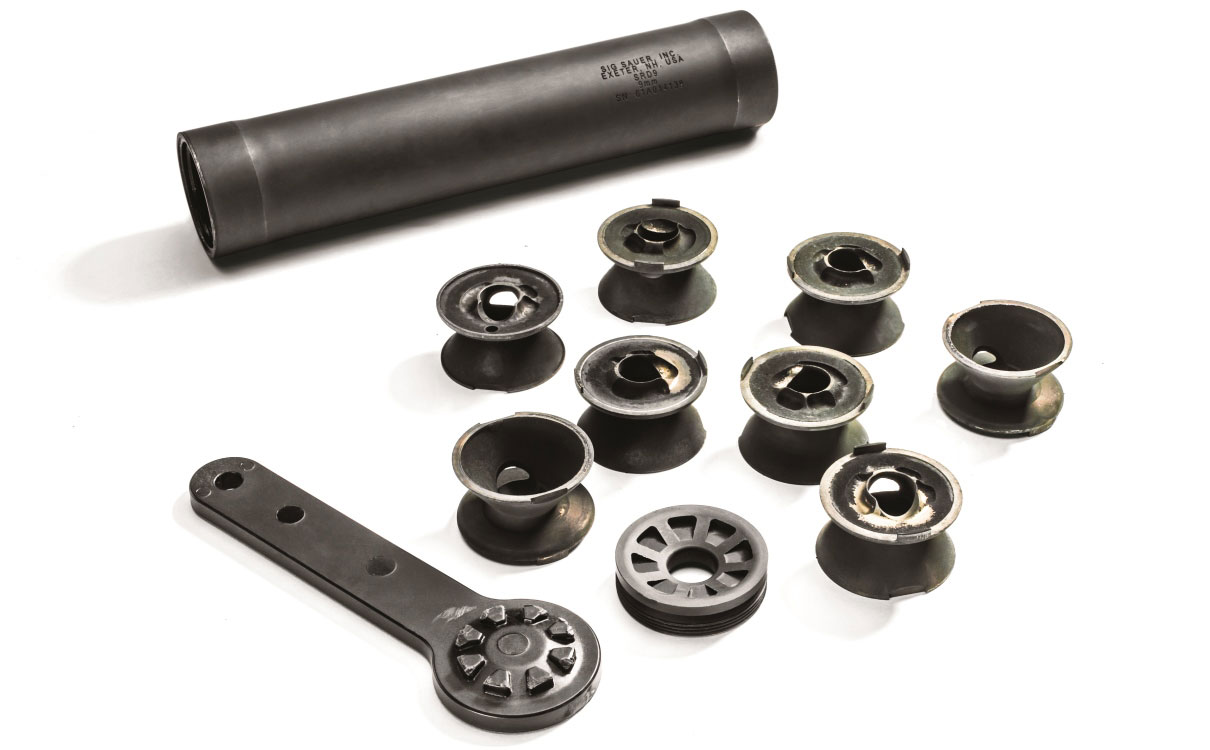
User maintenance is straightforward and easy to perform with the supplied wrench. (Sean Utley photo)
The SRD9 also disassembles for maintenance. While it’s easy to disassemble a user- maintainable suppressor, reassembly isn’t always as straightforward. Monocore designs reduce the complexity, but the SRD9 has a baffle stack of individual baffles. Fear not – SIG Sauer had the insight to design identical baffles, so there is no confusion when reassembling your suppressor. You can’t place them in the tube in the wrong order.
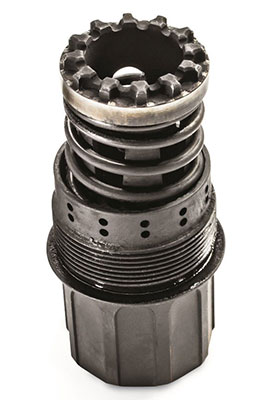 The SRD9 features an encapsulator with 21 notches so you can
The SRD9 features an encapsulator with 21 notches so you can
accurately time the suppressor to your pistol. (Sean Utley photo)Timing
As with all pistol suppressors, installing the SRD9 on your favorite pistol won’t immediately result in stellar accuracy. Unless you are incredibly lucky, there will be a change in point of impact, and the change could be significant. Because of this, the SRD9 features an encapsulator with 21 notches so you can accurately time the suppressor to your pistol. The process is simple. Fire a couple of rounds into your target to see where they’re impacting. It’s probably best to do this from a rest position. Now, grab the suppressor, pull it away from the pistol and twist at the same time. The suppressor will move and securely seat in the next notch. Be sure not to place your hand in front of the muzzle, and ensure that you are clear of the trigger. After turning the suppressor, fire a couple more shots and note the change in impact. Repeat this process until you are satisfied with the results.
We performed this procedure with our SIG Sauer P226, which is outfitted with a ROMEO1 red dot optic. You shouldn’t have to repeat this process unless you install your SRD9 on a different pistol or introduce new ammo to the mix.
Testing
Both a SIG Sauer MPX-K SMG and an FDE P226 MK25-D-RX with a threaded barrel were used to test drive the SRD9. They also supplied their V-Crown 147-grain ammunition. The P226 is an accurate pistol. Unsuppressed groups at 25 yards were impressive, averaging 1.62 inches for three, five-shot strings. Unfortunately, adding the SRD9 didn’t improve the results. Initially, it looked good when four-shot groups were at 1.05 inches, but an anomaly occurred and opened up groups on the last round to over 2 inches. Other groupings produced similar results. The encapsulator was adjusted several times, but the behavior couldn’t be eradicated. The change was rhythmic, happening on the same round count of each string, leading us to believe there was something awry in this particular SRD9.
Performance P226 MK25
| SIG SAUER V-Crown 147-gr. JHP |
Avg.
Group (in.) |
Best
Group (in.) |
| Unsuppressed |
1.62 |
1.1 |
| Suppressed |
3.41 |
2.32 |
POI Shift: 1.5 in. low
Measure Average Noise Reduction: -16dB
Testing Conditions: 88 degrees, 60 percent relative humidity
Accuracy results are the average of three, five-shot groups.
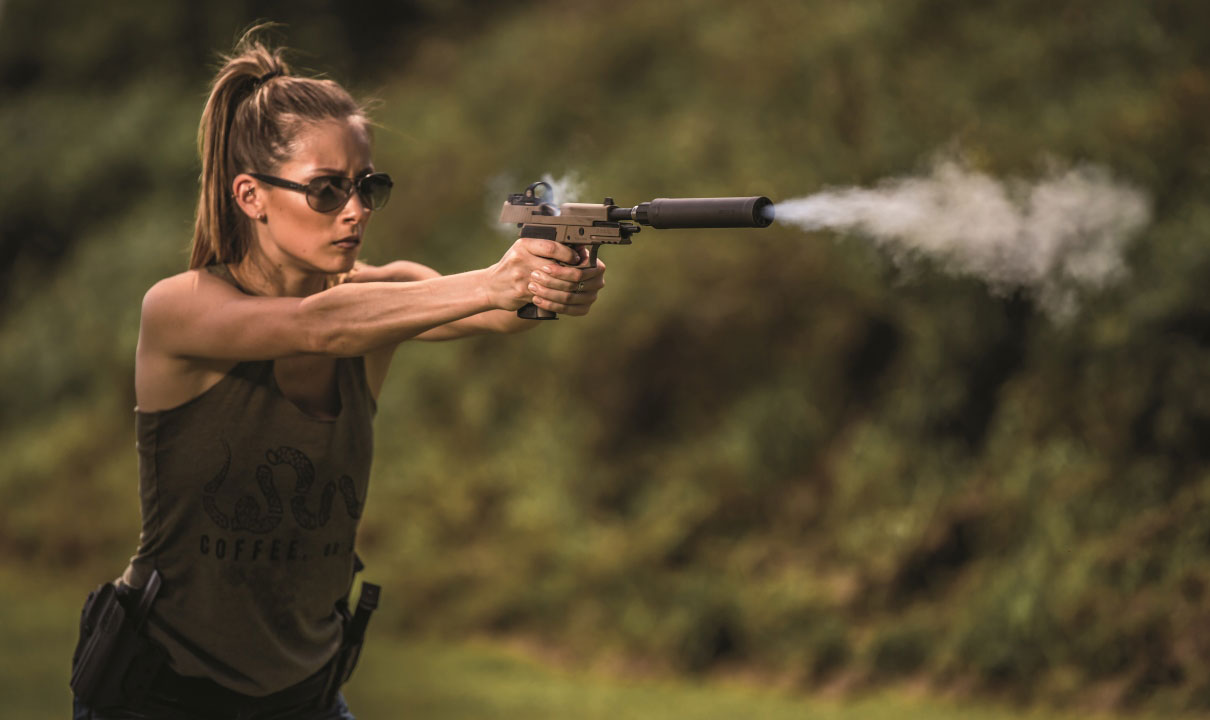
The P226 shoots flat with the SRD9 attached. It functions flawlessly with SIG Sauer V-Crown 147-grain ammunition. (Sean Utley photo)
MPX-K SMG
| SIG SAUER V-Crown 147-gr. JHP |
Avg.
Group (in.) |
Best
Group (in.) |
| Unsuppressed |
1.81 |
1.72 |
| Suppressed |
1.48 |
1.31 |
POI Shift: none
Measure Average Noise Reduction: -27dB
Testing Conditions: 88 degrees, 60 percent relative humidity
Accuracy results are the average of three, five-shot groups.
The results were different with a fixed barrel spacer installed on the MPX-K. Groups shrunk slightly from unsuppresed to suppressed; firing and point of impact didn’t change. Unsuppressed groups at 25 yards went from 1.84 inches unsuppressed to 1.48 inches with the SRD9 attached. A couple of the groups had four rounds on top of each other.
Both firearms functioned without issue with the SIG Sauer ammunition. The SRD9 was quiet on both firearms, and hearing protection wasn’t really necessary. That’s one cool factor with subsonic 9mm ammo.
Conclusion
SIG Sauer is working hard to keep up with demand for the SRD9. Rest assured that the SRD9 is tough and built to a professional-grade level of durability while remaining lightweight. We expect nothing less than this high level of capability from SIG Sauer. There are many 9mm suppressors to explore, and the SRD9 should be on your list.